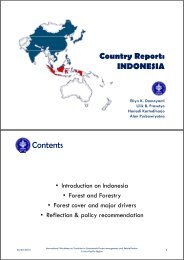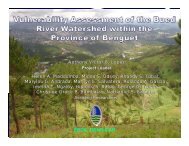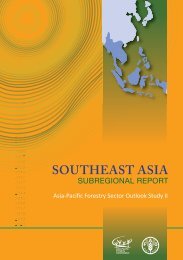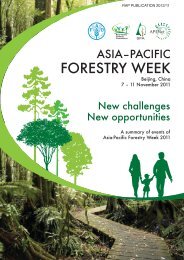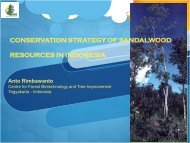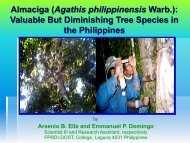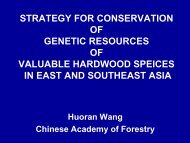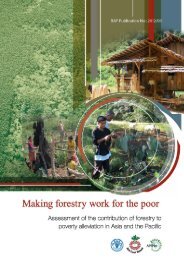Community guidelines for accessing forestry voluntary carbon ... - FAO
Community guidelines for accessing forestry voluntary carbon ... - FAO
Community guidelines for accessing forestry voluntary carbon ... - FAO
Create successful ePaper yourself
Turn your PDF publications into a flip-book with our unique Google optimized e-Paper software.
<strong>Community</strong> <strong>guidelines</strong> <strong>for</strong> <strong>accessing</strong> <strong>for</strong>estry <strong>voluntary</strong> <strong>carbon</strong> markets<br />
To contribute towards these goals, communities may focus on specific<br />
<strong>for</strong>est management objectives, <strong>for</strong> example:<br />
• Income generation from <strong>for</strong>est products;<br />
• Watershed management; or<br />
• Promotion of ecotourism, etc.<br />
The goals and objectives, and their broader impacts, should be<br />
defined by the community members directly concerned with <strong>for</strong>est<br />
management as well as all other groups and individuals who will be<br />
affected by the activities. The choice of project activity also depends<br />
largely on the existing vegetation. For instance, if the area is already<br />
covered by <strong>for</strong>est, but is being constantly degraded due to poor <strong>for</strong>est<br />
management practices, the activities to be implemented will fall under<br />
the IFM category.<br />
ARR and REDD are relatively straight<strong>for</strong>ward in terms of defining the<br />
activity to be implemented. However, the enabling conditions required<br />
to undertake the activities may be quite challenging. IFM projects may<br />
take many different <strong>for</strong>ms, as discussed below. However, in all cases,<br />
potential project developers must first ask themselves: “Is a <strong>for</strong>estry<br />
project viable?” Regardless of the VCM, <strong>for</strong>estry must compete with a<br />
number of other potential land uses. In some cases, such as governmentsanctioned<br />
infrastructural developments, the decision is taken out of<br />
the hands of the community and the VCM has little relevance. In other<br />
cases, different sets of stakeholders may have very different ambitions<br />
<strong>for</strong> the same piece of land, leading to prolonged conflict and social<br />
tension. As discussed in Chapter 6, some risks to project development<br />
can be identified very early on. Others may become clear only at a later<br />
stage.<br />
34




